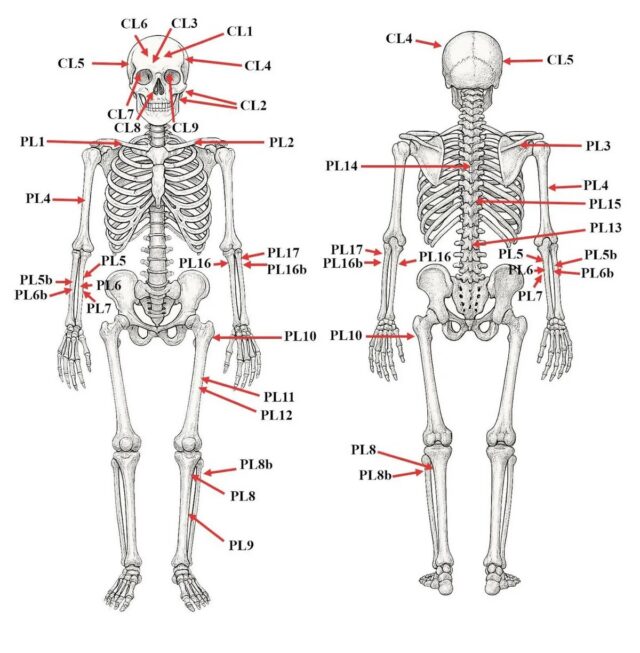It’s a regrettable reality that there is never enough time to cover all the interesting scientific stories we come across each month. In the past, we’ve featured year-end roundups of cool science stories we (almost) missed. This year, we’re experimenting with a monthly collection. November’s list includes forensic details of the medieval assassination of a Hungarian duke, why woodpeckers grunt when they peck, and more evidence that X’s much-maligned community notes might actually help combat the spread of misinformation after all.
An assassinated medieval Hungarian duke
 Credit:
Tamás Hajdu et al., 2026
Credit:
Tamás Hajdu et al., 2026
Back in 1915, archaeologists discovered the skeletal remains of a young man in a Dominican monastery on Margaret Island in Budapest, Hungary. The remains were believed to be those of Duke Bela of Masco, grandson of the medieval Hungarian King Bela IV. Per historical records, the young duke was brutally assassinated in 1272 by a rival faction and his mutilated remains were recovered by the duke’s sister and niece and buried in the monastery.
 Der Geekom A6 Mini-PC mit Ryzen-7-CPU, schnellem Speicher und Windows 11 Pro ist bei Amazon nur noch heute rund 75 Euro reduziert. (
Der Geekom A6 Mini-PC mit Ryzen-7-CPU, schnellem Speicher und Windows 11 Pro ist bei Amazon nur noch heute rund 75 Euro reduziert. ( Die Blink Outdoor 4 ist eine kabellose HD-Sicherheitskamera mit IP65-Schutz und wird im 2-Kamera-Set mit Sync Modul geliefert. (
Die Blink Outdoor 4 ist eine kabellose HD-Sicherheitskamera mit IP65-Schutz und wird im 2-Kamera-Set mit Sync Modul geliefert. ( Auch in anderen Fragen richtet sich der norwegische Staatsfonds gegen die Abstimmungsempfehlungen des Microsoft-Managements. (
Auch in anderen Fragen richtet sich der norwegische Staatsfonds gegen die Abstimmungsempfehlungen des Microsoft-Managements. ( Zum Ausklang der Black Friday Woche ist das Elgato Stream Deck MK.2 mit 15 programmierbaren Tasten bei Amazon um 60 Euro reduziert. (
Zum Ausklang der Black Friday Woche ist das Elgato Stream Deck MK.2 mit 15 programmierbaren Tasten bei Amazon um 60 Euro reduziert. ( Die Switch-2-Version von Assassin's Creed Shadows überzeugt mit stabilem Spielgefühl und starker Optik. Vergleichsbilder zeigen Unterschiede. Ein Test von Peter Steinlechner (
Die Switch-2-Version von Assassin's Creed Shadows überzeugt mit stabilem Spielgefühl und starker Optik. Vergleichsbilder zeigen Unterschiede. Ein Test von Peter Steinlechner ( Eine Security-Spezialistin erklärt uns, warum die Zahl der Software-Sicherheitslücken schneller wächst als der eigentliche Programmcode. Ein Bericht von Lars Lubienetzki (
Eine Security-Spezialistin erklärt uns, warum die Zahl der Software-Sicherheitslücken schneller wächst als der eigentliche Programmcode. Ein Bericht von Lars Lubienetzki ( Der Philips 5000-Serie-Sandwichmaker bringt heiße Waffeln, knusprige Panini und goldene Sandwiches in nur wenigen Minuten auf den Tisch. (
Der Philips 5000-Serie-Sandwichmaker bringt heiße Waffeln, knusprige Panini und goldene Sandwiches in nur wenigen Minuten auf den Tisch. ( Ein Forscher hat alle öffentlichen Gitlab-Repos auf Zugangsdaten gescannt. Er fand mehr als 17.000, erhielt aber nur eine recht dürftige Belohnung. (
Ein Forscher hat alle öffentlichen Gitlab-Repos auf Zugangsdaten gescannt. Er fand mehr als 17.000, erhielt aber nur eine recht dürftige Belohnung. (